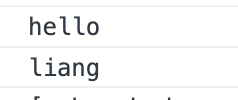接 Vue2剥丝抽茧-响应式系统 (opens new window)、Vue2剥丝抽茧-响应式系统之分支切换 (opens new window),响应式系统之嵌套 (opens new window)还没有看过的同学需要看一下。
# 场景
import { observe } from "./reactive";
import Watcher from "./watcher";
const data = {
text: {
innerText: {
childText: "hello",
},
},
};
observe(data);
const updateComponent = () => {
console.log(data.text.innerText.childText);
};
new Watcher(updateComponent);
data.text.innerText.childText = "liang";
我们的响应式系统到现在还没有支持属性是对象时候的响应,因此我们改变 childText 的时候不会有任何输出。
我们只收集了 data.text 的依赖,所以如果想要响应的话必须给 data.text 整个赋值为一个新对象。
import { observe } from "./reactive";
import Watcher from "./watcher";
const data = {
text: {
innerText: {
childText: "hello",
},
},
};
observe(data);
const updateComponent = () => {
console.log(data.text.innerText.childText);
};
new Watcher(updateComponent);
data.text = {
innerText: {
childText: "liang",
},
};

我们当然不希望每次都赋值整个对象,我们需要做一些修改,把嵌套的对象也变成响应式的。
# 方案
我们只需要在给某个 key 重写 get 和 set 之前,把它的 value 就像上边给 data 调用 observe 函数一样,也调用一次 observe 函数即可。
同时提供 shallow 参数,留下扩展,让外界决定是否需要深度响应。
/*******************新增 shallow*******************/
export function defineReactive(obj, key, val, shallow) {
/****************************************************/
const property = Object.getOwnPropertyDescriptor(obj, key);
// 读取用户可能自己定义了的 get、set
const getter = property && property.get;
const setter = property && property.set;
// val 没有传进来话进行手动赋值
if ((!getter || setter) && arguments.length === 2) {
val = obj[key];
}
const dep = new Dep(); // 持有一个 Dep 对象,用来保存所有依赖于该变量的 Watcher
/*******************新增****************************/
!shallow && observe(val);
/******************************************************/
Object.defineProperty(obj, key, {
enumerable: true,
configurable: true,
get: function reactiveGetter() {
const value = getter ? getter.call(obj) : val;
if (Dep.target) {
dep.depend();
}
return value;
},
set: function reactiveSetter(newVal) {
if (setter) {
setter.call(obj, newVal);
} else {
val = newVal;
}
dep.notify();
},
});
}
同时,在 observe 函数中,传进来的 value 不是对象的话我们直接 return 。
/*
util.js
export function isObject(obj) {
return obj !== null && typeof obj === "object";
}
*/
export function observe(value) {
if (!isObject(value)) {
return;
}
let ob = new Observer(value);
return ob;
}
# 场景2
import { observe } from "./reactive";
import Watcher from "./watcher";
const data = {
text: {
innerText: {
childText: "hello",
},
},
};
observe(data);
const updateComponent = () => {
console.log(data.text.innerText.childText);
};
new Watcher(updateComponent);
data.text.innerText.childText = "liang";
data.text = {
innerText: {
childText: "liang2",
},
};
data.text.innerText.childText = "liang3";
可以一分钟想一下上边会输出什么。
... ...
new Watcher(updateComponent); ,执行一次 updateComponent 输出 hello 。
data.text.innerText.childText = "liang"; ,我们已经解决了属性是对象的情况,因此这里也会输出 liang。
data.text = {
innerText: {
childText: "liang2",
},
};
上边代码就是文章最开头的方法,因此也会触发函数执行,输出 liang2 。
data.text.innerText.childText = "liang3"; 最后这句会执行吗?
答案是否定的了,因为我们的 data.text 赋值为了一个新对象,但这个新对象我们并没有将其设置为响应式的。
因此我们需要在 set 的时候把对象也设置为响应式的。
/**
* Define a reactive property on an Object.
*/
export function defineReactive(obj, key, val, shallow) {
const property = Object.getOwnPropertyDescriptor(obj, key);
// 读取用户可能自己定义了的 get、set
const getter = property && property.get;
const setter = property && property.set;
// val 没有传进来话进行手动赋值
if ((!getter || setter) && arguments.length === 2) {
val = obj[key];
}
const dep = new Dep(); // 持有一个 Dep 对象,用来保存所有依赖于该变量的 Watcher
let childOb = !shallow && observe(val);
Object.defineProperty(obj, key, {
enumerable: true,
configurable: true,
get: function reactiveGetter() {
const value = getter ? getter.call(obj) : val;
if (Dep.target) {
dep.depend();
}
return value;
},
set: function reactiveSetter(newVal) {
if (setter) {
setter.call(obj, newVal);
} else {
val = newVal;
}
/******新增 *************************/
childOb = !shallow && observe(newVal);
/************************************/
dep.notify();
},
});
}
# 总
通过递归解决了属性是对象的依赖,可以为未来数组的依赖留下基础。
← 4.响应式系统完善 6.响应式系统之数组 →